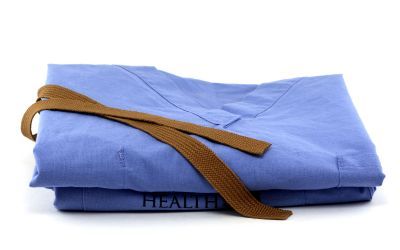Study Suggests Use of Antimicrobial Scrubs May Reduce Bacterial Burden on Healthcare Worker Apparel

The use of antimicrobial-impregnated scrubs combined with good hand hygiene is effective in reducing the burden of methicillin-resistant Staphylococcus aureus (MRSA) on healthcare workers apparel and may potentially play a role in decreasing the risk of MRSA transmission to patients, according to a new study from Virginia Commonwealth University researchers.
Previous findings have shown that hospital textiles may contribute to the transmission of pathogens through indirect contact via the hands of hospital staff and that antimicrobial textiles may reduce the bioburden, or the number of bacteria living on a surface before sterilization in clinical settings.
Led by Gonzalo Bearman, MD, MPH, associate professor of internal medicine in the VCU School of Medicine and associate hospital epidemiologist at the VCU Medical Center, the study A Crossover Trial of Antimicrobial Scrubs to Reduce Methicillin-Resistant Staphylococcus Aureus Burden on Healthcare Worker Apparel, is currently available online and will appear in the March issue of the journal Infection Control and Hospital Epidemiology.
We strive to study infection prevention interventions that are simple yet effective for the reduction of health care associated infections, says Bearman. The goal is to affect change or implement risk reduction by methods that are both easily implemented and sustained.
In the study, 32 healthcare workers wore four pairs of identically appearing control scrubs and study scrubs impregnated with an antimicrobial, or germ-killing, compound over the course of four months, washing them regularly. Participants also received identical hand hygiene educational sessions every four weeks, and researchers assessed compliance with hand hygiene practices.
Researchers conducted once weekly, unannounced, garment and hand cultures of participants at the start and end of each shift where they obtained two samples from the garments abdominal area and cargo pant pocket two areas of high-touch and high bacterial colonization.
According to Bearman, although the scrubs did not impact the degree of MRSA on the healthcare workers hands, the antimicrobial scrubs were effective in reducing the burden of MRSA on healthcare worker apparel.
It is critical for healthcare workers and patients to understand that the environmentincluding inanimate surfaces and apparel is not sterile, and is frequently a reservoir of drug resistant bacteria, says Bearman. Meticulous hand hygiene at the point of patient care is critical for reducing the risk of a hospital-acquired infection.
If widespread antimicrobial scrub use were added to existing infection prevention strategies, a further decrease in hospital acquired infections may occur by limiting the cross transmission of pathogens via apparel. The actual impact of antimicrobial scrubs on hospital acquired infections needs further study, he adds.
The scrubs tested in the study were manufactured by Vestagen Technical Textiles.
Bearman collaborated with VCU researchers Kakotan Sanogo, Michael P. Stevens, MD, Curtis Sessler, MD, Richard Wenzel, MD, along with Adriana Rosato, PhD, Methodist Hospital Research Institute and Kara Elam, doctoral student, University of Mississippi.
Bridging the Gap: Operating Room and Central Processing Unite to Improve Surgical Efficiency
April 8th 2025Communication breakdowns between the operating room and central processing led to delays and frustration—until collaboration, cross-training, and shared goals turned metrics around and strengthened teamwork.